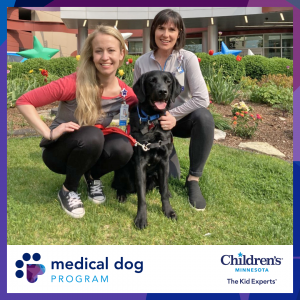Children’s Minnesota is excited to welcome our first medical dog, Riggs, as part of our new medical dog program, thanks to donor support from the Teammates for Kids Foundation and Bond family.
Meet Riggs, Children’s Minnesota’s first medical dog
Two-year-old Riggs officially joined the Children’s Minnesota team on May 15, 2023, and currently serves patients at our St. Paul hospital alongside his handlers and child life specialists, Annika Kuelbs and Krista Majerus.
Riggs and his primary handler, Annika, work with patients at our St. Paul hospital recovering on the medical-surgical unit and patients at the Center for Treatment of Eating Disorders. But that’s not all! Riggs also spends time with all patient families inside The Child Life Zone alongside his secondary handler, Krista Majerus.

Like a regular full-time employee, Riggs works a 40-hour week, then goes home at the end of the day with his primary handler, Annika.
Learn more about Riggs
Medical dog training
Before coming to Children’s Minnesota, Riggs received special training at Can Do Canines, a Twin Cities-based organization dedicated to enhancing the quality of life for people with disabilities by creating mutually beneficial partnerships with specially trained dogs.
“We are so grateful for our partnership with Can Do Canines to help train and match us with Riggs. They’ve been a valued partner throughout this experience with our hospital’s first medical dog,” said Joy Johnson-Lind, senior director of child and family services.
What is a medical dog?
Medical dogs, also known as facility dogs, are expertly trained to help patients cope with medical conditions and work toward their treatment goals. And of course, they bring smiles and laughter to patients during what can be a challenging time in the hospital.
Our child life specialists play a vital role in the care of our patient families throughout their time in the hospital. They help ease stress and anxiety by promoting positive coping during treatments. Essentially, medical dogs are a canine extension of the services and support our child life specialists provide to patient families.
A few examples of the kinds of support medical dogs provide includes:
- Helping patients cope during certain procedures such as pokes, line pulls or NG placement to distract patients with a trick or lend a paw to squeeze.
- Demonstrating how to do a particular task if the patient is anxious (examples include oral pills, vitals, labs, etc.)
- Getting patients up and moving. Medical dogs can play hide-and-seek, play games or go for walks with patients.
Medical dogs vs. therapy pets
While both medical dogs and therapy pets bring joy and make the hospital more comfortable for patients, the kind of support that Riggs provides is more extensive due to the special training he received at Can Do Canines.
Medical dogs work alongside hospital staff, like child life specialists, to help motivate patients to meet their health treatment goals through play, preparation for procedures or support. Volunteer therapy animals, such as those through our Pets Assisting with Healing (PAWHs) program, typically visit with patients and families in common areas of the hospital or in patient rooms to bring comfort and cheer. Many of these therapy pets visit with their owners weekly or several times a month.
“Our goal is to continue to grow the medical dog program so we have more medical dogs and handlers who can serve patients while they recover in the hospital. We are so excited to have Riggs and jumpstart this program at Children’s Minnesota!” said Joy.
Join the pawty!
Follow Riggs’ Instagram to stay up to date on his adventures at Children’s Minnesota.